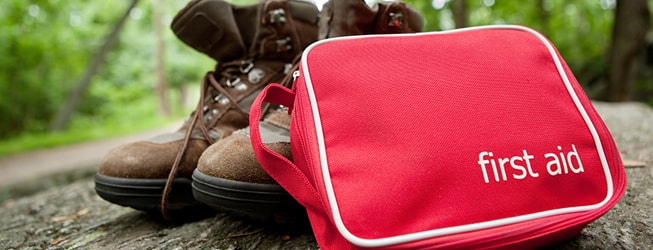Rescue Breathing and CPR

A victim may stop breathing for a number of reasons (i.e. drowning, electric shock, heart failure, poisoning, or suffocation). The flow of oxygen throughout the body stops within a matter of minutes if a person's respiratory system fails. Heart failure, brain damage, and eventual death will result if the victim's breathing cannot be restarted.
Before you begin rescue breathing, be certain that the victim has actually stopped breathing.
Kneel beside the victim, place your ear near his/her nose and mouth, and watch his/her chest carefully. You should feel and hear the breaths and see his/her chest rise and fall if he is breathing.
IF HE/SHE IS NOT BREATHING:
- Provide an open airway. Carefully place the victim on his/her back and open his/her mouth. If any material is blocking the airway, it must be cleared out.
- Tilt the victim's head back by placing the heel of one hand on his/her forehead and the other hand under the bony part of his/her chin to lift it slightly.
- Straddle his/her thighs, placing one palm slightly above the navel but well below the breastbone. Cover this/her hand with the other and interlace the fingers.
- Without bending your elbows, press sharply on the victim's abdomen 6-10 times.
- Turn the victim's head to one side and sweep out any contents in his/her mouth with your fingers.
- If the victim's breathing is not restored after removing the object, reposition his/her head in the head-tilt/chin-lift position and continue breathing for him as long as is necessary or until help arrives.
- If there are no signs of breathing, pinch the victim's nostrils closed. Seal your mouth over the victim's mouth and blow two full breaths. A rising chest indicates that air is reaching the lungs. If the stomach is expanding instead, the victim's neck and jaw are positioned improperly. Gently push on the victim's abdomen with the palm of your hand until the air is expelled, because the extra air in the stomach may cause vomiting.
- Look, listen, and feel again for signs of breathing. If the victim is still not breathing on his/her own, contnue blowing into his/her mouth one breath every five seconds until help arrives.
CHILDREN (1 - 8 YEARS):
Same as for an adult. When performing CPR on a child , keep in mind that the lung capacity of a child is far less than that of an adult. Use less pressure in chest compressions (press one to one-half inches into chest) and less force in when rescue breathing (enough to see the chest rise). Give 2 slow, thorough breaths, with a pause in between. (Note: An adult's lungs are much larger than a child's, so use small breaths and blow just enough to make the child's chest rise.)
INFANTS:
If you are working with infants (under 1 year), position your mouth so that you can blow through the child's nose and mouth at the same time. Give two puffs, using your mouth and cheeks for breathing air into the infant's lungs (to keep from overinflating the lungs). Administer one breath every 3-4 seconds.


